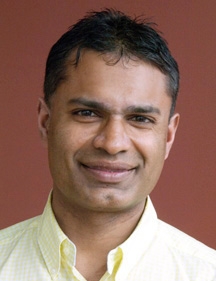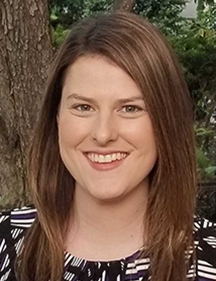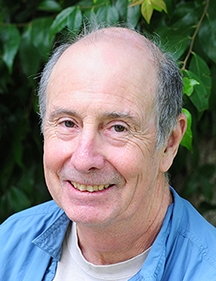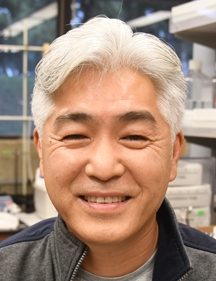

From basic science to applied science.
From studying insects to helping humankind.
The ovarian cancer research published today in the Proceedings for the National Academy of Science (PNAS) can be traced back, in part, to a former graduate student at UC Berkeley trying to answer some basic questions on how a caterpillar becomes a butterfly.
Metamorphosis.
In investigating those basic questions, that graduate student, Bruce Hammock, and fellow graduate student Sarjeet Gill, co-discovered a soluble epoxide hydrolase (sEH). Both scientists are now distinguished professors in the UC system: Hammock, a distinguished professor at UC Davis, and Gill, a distinguished professor at UC Riverside.
For the past 50 years, Hammock has been studying sEH inhibitors, leading to drugs that target such diseases as diabetes, hypertension (heart disease), Alzheimer's disease, and cancer. He recently formed a Davis-based company, EicOsis, to develop an orally active non-addictive drug for inflammatory and neuropathic pain for human beings and companion animals. Human clinical trials are scheduled to begin in 2019. Several seed-fund grants and a NIH/NINDS (National Institute of Neurological Disorders and Stroke) Blueprint Development Grant support EicOsis.
But back to the research published today in PNAS.
Did you know that chemotherapy kills cancer cells, but that the debris of dead and dying cells can lead to inflammation and the surge of more cancerous cells?

The research is the work of a 13-member team from Harvard Medical School/Beth Israel Deaconess Medical Center (BIDMC), UC Davis, Institute of Systems Biology of Seattle, and Emory University School of Medicine of Atlanta. They tested the compound on mice models.
Lead author Allison Gartung of Harvard Medical School/BIDMC described the research as a “novel approach to suppressing therapy-induced tumor growth and recurrence. To prevent tumor-recurrence after therapy, it will be critical to neutralize the inherent tumor-promoting activity of therapy-generated debris,” she said. "Our results indicate that a dual COX-2/sEH inhibitor may offer a novel alternative to protect the body from a debris-mediated inflammatory response.”
Gartung said that the study confirms that chemotherapy-killed ovarian cancer cells “induce surrounding immune cells called macrophages to release a surge of cytokines and lipid mediators that create an optimal environment for tumors to survive and grow.
Hammock, who holds a joint appointment with the Department of Entomology and Nematology and the UC Davis Comprehensive Cancer Center, lamented that “Chemotherapy and surgery, the mainstays of conventional cancer treatment, can act as double-edged swords. It is tragic that the very treatments used to cure cancer are helping it to survive and grow."

Chemist Sung Hee Hwang of the Hammock lab developed the compound, known as PTUPB, for the study. “The dual inhibitor here follows earlier work we did with it, blocking breast and lung tumors in mice,” Hammock said. “PTUPB is already being clinically evaluated for its therapeutic properties in other diseases.” Chemist Jun Yang of the Hammock lab did the mass spectrometry, showing how stabilization of lipid mediators reduces cancer growth and metastasis.
Lead researcher Dipak Panigrahy, a former Harvard physician turned full-time researcher, described chemotherapy and surgery “as our best tools for front-line cancer therapy, but chemotherapy and surgery create cell debris that can stimulate inflammation, angiogenesis, and metastasis. Thus, the very treatment used by oncologists to try to cure cancer is also helping it survive and grow. Overcoming the dilemma of debris-induced tumor progression is critical if we are to prevent tumor recurrence of treatment-resistance tumors which lead to cancer therapy failure.”
The tumor cell debris generates a “cytokine surge” that can result in a perfect storm for cancer progression. “The dual inhibitor acts as a surge protector,” Panigrahy said.
Panigrahy, who led angiogenesis and cancer animal modeling in the laboratory of Judah Folkman, a leading cancer research laboratory, based the debris model on his mother's chemotherapy treatments, and dedicated the research to his mother and “all other women who lost their lives to ovarian cancer.” American Cancer Society statistics show that among women, ovarian cancer ranks fifth in cancer deaths. A woman's risk of ovarian cancer is about 1 in 78; every year more than 14,000 die from the disease.
“Traditional cancer therapy sets up a dilemma,” Panigrahy commented. “Yes, we need to kill cancer cells but the inevitable byproduct of successfully doing so also stimulates tumor regrowth and progression. The more tumor cells you kill, the more inflammation you create, which can inadvertently stimulate the growth of surviving tumor cells. Overcoming the dilemma of debris-induced tumor progression is paramount if we are to prevent tumor recurrence of treatment-resistant tumors – the major reason for failure of cancer therapy. Our studies potentially pave the path for a new strategy for the prevention and treatment of chemotherapy-induced resistance with potential to translate to the clinic. If successful, this approach may also allow us to reduce the toxic activity of current treatment regimens.”
“The collaborative work in this paper not only defines a common problem with current cancer therapy, but it actually offers a potential solution to reduce metastasis and tumor growth following therapy,” said Primo Lara Jr., director of the UC Davis Comprehensive Cancer Center and associate director of Translational Research. “I am pleased that our Center was involved in this exciting project and we hope we can be involved in translating this basic research to the clinic.”
Panigrahy said that non-steroidal anti-inflammatory drugs (NSAIDs), which include aspirin and ibuprofen, reduce pain, fever and inflammation “bit may have severe side effects including stomach and brain bleeding as well as severe cardiovascular and kidney toxicity. They also do not specifically enhance clearing of debris.”
“We are exploring all options to translate PTUPB to cancer patients especially in combination with current cancer therapies such as chemotherapy, radiation, immunotherapy, or surgery which either directly or indirectly may generate tumor cell debris,” Panigrahy said. “Our next step is to investigate whether our findings are consistent with clinical studies involving human cancer.”
Said Hammock: "We have a series of papers largely in PNAS, with the Panigrahy group showing first our soluble epoxide hydrolase inhibitors block tumor growth and metastasis when used with omega3 fish oils or with COX inhibitors and the role for these compounds in regulating a number of mediators of cancer growth."
And to think this all began with a young graduate student at UC Berkeley studying how caterpillars become butterflies.
Attached Images:

An anise swallowtail caterpillar, Papilio zelicaon. UC Davis distinguished professor Bruce Hammock's research on metamorphosis has led to human-focused research. (Photo by Kathy Keatley Garvey)

An anise swallowtail,Papilio zelicaon. UC Davis distinguished professor Bruce Hammock's research on metamorphosis has led to human-focused research. (Photo by Kathy Keatley Garvey)